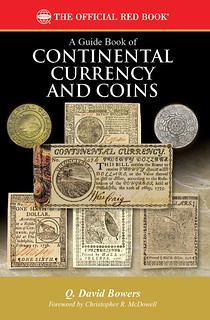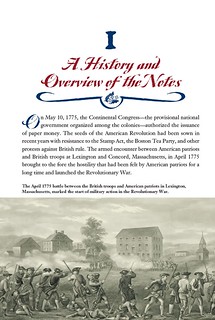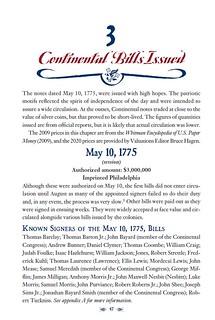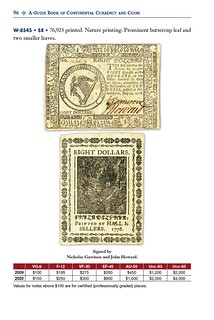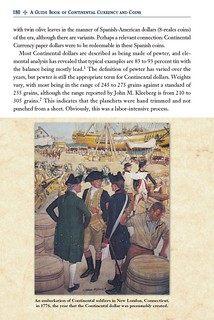
PREV ARTICLE
NEXT ARTICLE
FULL ISSUE
PREV FULL ISSUE
REVIEW: GUIDE BOOK OF CONTINENTAL CURRENCYHere's a great review by Christopher McDowell of the new Whitman Guide Book of Continental Currency and Coins by Dave Bowers. -Editor The Guide Book of Continental Currency and Coins, the latest Whitman Publishing book by Q. David Bowers, debuts March 2, 2021. The 288-page book is volume 25 in the popular Bowers Series of numismatic references. It will be available from bookstores and hobby shops and online (including at Whitman.com) for $19.95. Here, Journal of Early American Numismatics editor Christopher R. McDowell explores the importance of the new book.
In Praise of Bowers's Unique Study of Revolutionary Currency
I am the editor of the Journal of Early American Numismatics, formerly the Colonial Newsletter, a publication of the American Numismatic Society. I had known of Dave Bowers for decades before I met him, but we were personally introduced after I wrote an article on Daniel Van Voorhees, an eighteenth-century New York silversmith involved in the production of Vermont copper coinage of the 1785 to 1788 period. Dave contacted the publisher to ask if he could have a special copy of my article, which I agreed to. From that day to now we have corresponded weekly, sometimes daily, regarding colonial numismatics. Although Dave's interest extends beyond American colonial numismatics, the coins and currency of the Revolutionary period have been of special interest to him since the 1950s. He has been involved in the sale of the finest colonial collections ever assembled and has known most of the great collectors of the twentieth century, but Dave is also a scholar. He has written and sold more books than any other numismatic author past or present. His books are both popular and influential.
What is the secret sauce that makes Bowers's books so popular? That is the question I asked myself when he first made me aware he was working on this project. Fortunately, I was permitted to be part of the action and watch as the manuscript moved from concept to physical book. Through this experience I gained valuable insight into how Dave operates. He is without a doubt the current The first ingredient in Dave's secret sauce is a great topic. This book fills a void—a gap in our numismatic knowledge that screams to be filled by a single, easily available study. For reasons that will never be clear to me, numismatists have in the past segregated currency from coins in written works. Even at auctions, colonial currency is sold in one room and coins in another. I remember striding into an auction in Baltimore to take my seat when a friend approached me to say I must be lost, as they were auctioning colonial currency in that room and the colonial coin auction was in the next room over. Why can't both be in the same room? Why can't both be in the same book? Certainly our forefathers did not reserve one pocket for paper and the other for silver. Both circulated together, and both should be studied and enjoyed together. The Guide Book of Continental Currency and Coins does that. It brings into one place both paper currency and coins, the way things were meant to be. The second ingredient is superb research. Dave's unparalleled numismatic knowledge is, of course, a huge advantage, but no single person can know everything. So, he has gathered many friends around him who are experts in a wide range of subjects. When he comes across a topic where he knows someone else has been conducting research, he contacts that person to learn what's new. As Dave put together this book, he contacted dozens of experts to ask questions. In this way, he made sure that what he wrote was correct and up to date. The world of colonial and early American numismatics is in a state of flux. New ideas and theories are questioning and sometimes upending many of the concepts that were once considered established dogma. Take, for example, the Continental dollar coin. In recent years our view of this coinage has changed considerably. In writing this book, Dave contacted all the major players in the current debate over the origin of this coinage and synthesized their thoughts and writings; however, he did not just parrot back other's thoughts, but he analyzed everything and made it his own. This same process was repeated over and over as this book moved forward to completion. Dave strives to get it right and plugs away until he does. Thus, I can say that this book brings forth the most up-to-date and accurate information available in any single book on the topic of Revolutionary-era paper currency and coins. The third ingredient is readability. Many of the topics contained in this book are complex, but Dave has a way of making everything easy to understand. In this way his works can be enjoyed by both the novice collector and the advanced numismatist. In preparing this book, Dave was particularly struck by the fact that Congress forced its ever-depreciating bills on the public. That is, as the value of Continental bills began to decline from over-production, counterfeiting, and hyper-inflation, Congress began to require, under penalty of law, that unwilling merchants accept them at face value. Those who refused were labelled Tories and subject to all sorts of deprivation, ridicule, or worse. This totalitarianism is not an account printed in our history books, but it is a fact brought to life in these pages. The hidden story of these bills and coins is an important and underappreciated aspect of this nation's founding. By gaining a fuller understanding of this topic, we can better appreciate the struggles of the Revolutionary era. Part of readability in numismatics is having great illustrations. All of Dave's books, including this one, contain images of the very finest bills and coins available. Dave is able to draw from his own collection, the library of Stack's Bowers Galleries, and selected private and public sources to bring to the reader the best of the best. These images enhance the experience like nothing else can. There are hundreds of images in this book. The final ingredient is setting an available price point without skimping on quality. Far too many of the numismatic books published today cost on the far side of $100 and are thus of small print runs and are seen by a relatively restricted audience. Dave strives to price his books at a level that makes them accessible to the general public. This is nowhere more evident than with the present publisher: Whitman Publishing, which has issued dozens of his titles and editions. At the same time, all of his books are nicely bound, with fine paper, and include beautiful color images. As a general rule, books such as this are not read and thrown away, but rather purchased with the intent to be placed on a bookshelf and enjoyed over a lifetime. Thus, it is important that the book be a quality product specially designed to last and be displayed for years to come. Dave's extensive experience in publishing makes it possible for him to create and have others publish a very high-quality product at a price everyone can afford. The Guide Book of Continental Currency and Coins includes all the ingredients that make for a superb numismatic publication. After reading it you will have a much greater understanding and appreciation not only of the currency and coins of the Revolutionary period, but also of the hardships faced by our forefathers in shaping this great nation. Christopher R. McDowell studied history and political science while enlisted in the U.S. Army, graduating with a bachelor's degree from Marshall University in West Virginia. He earned his J.D. at West Virginia University College of Law, after which he served as an Army officer overseas in the JAG Corps. Today McDowell is an attorney focusing on criminal and commercial-related litigation as well as real-estate transactions. As editor of the Colonial Newsletter (and now the Journal of Early American Numismatics), he assists other researchers in uncovering the mysteries and correcting the record of our numismatic past, as well as conducting his own extensive research and writing. A Guide Book of Continental Currency and Coins By Q. David Bowers; foreword by Christopher R. McDowell; research associates Julia Casey and Ray Williams; valuations editor Bruce Hagen.
ISBN 0794848400
To read the earlier E-Sylum article, see:
Wayne Homren, Editor The Numismatic Bibliomania Society is a non-profit organization promoting numismatic literature. See our web site at coinbooks.org. To submit items for publication in The E-Sylum, write to the Editor at this address: whomren@gmail.com To subscribe go to: https://my.binhost.com/lists/listinfo/esylum All Rights Reserved. NBS Home Page Contact the NBS webmaster |
